
Wagenstetter haulage firm already had the chance to test a pre-series version of the new Actros
Vehicle & Technology
At the transport company Nikolaus Wagenstetter, both management and drivers swear by the new Actros. The flagship from Mercedes‑Benz Trucks lowers fuel costs, boosts safety and offers drivers a modern and extremely attractive workplace in times when drivers are in short supply.
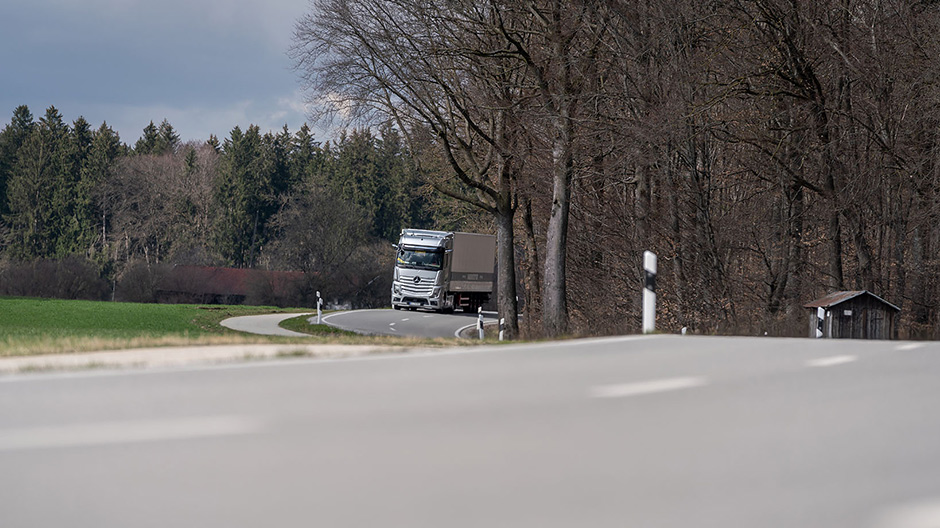
Predictive Powertrain Control can now also be used on rural routes and makes a substantial contribution towards the new Actros’ fuel saving of up to five per cent compared with its predecessor.
Nikolaus Wagenstetter is an entrepreneur in the true sense of the word: “We are not meant to spend our lives sitting around; we are meant to get things done,” is the motto of the forwarding agent from Forsting, about 50 kilometres east of Munich. Even at 69 years old, this livewire from Upper Bavaria is still bursting with energy: Wagenstetter is lobbying for changes to be made to their regional railway, to make it easier for the commuters living in his community to get to the state capital. He participates in international soap box races driving self-designed (and rather stylish) contraptions. He also still successfully manages the transport company his father, who was also called Nikolaus, founded 80 years ago.
“It’s been that way for decades: The amount of our revenue is largely determined by the price of diesel and the fuel consumption of our trucks,” says Wagenstetter, speaking from experience. “There is not much we can do about the price of diesel; we just have to live with it. But we can do quite a bit to make sure our trucks use as little fuel as possible – this is one factor over which we do have significant leverage. This is why I have always been interested in efficiency-boosting technologies in truck design, and so I offered to trial Daimler’s prototypes in our business – including the new Actros.
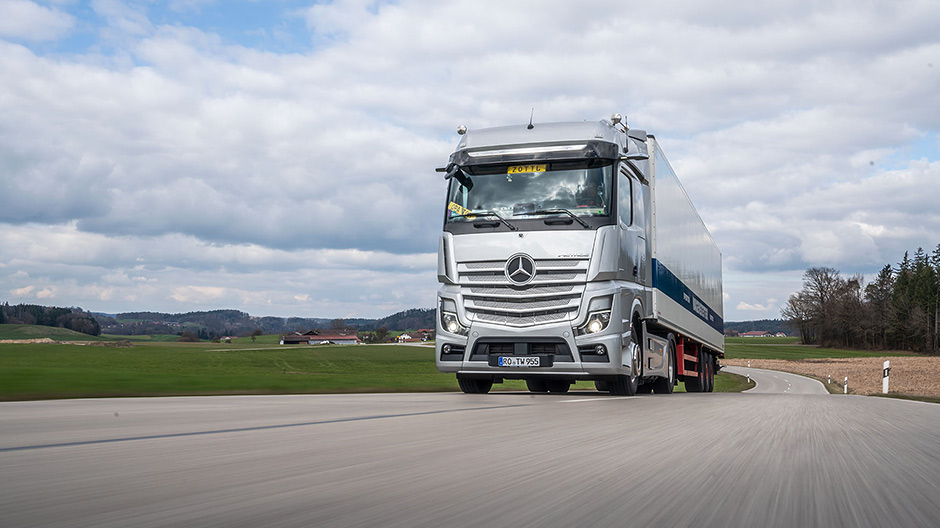
Sleek presence: MirrorCam instead of mirrors – not only does it boost safety; it also improves the truck’s aerodynamics.
Extreme mileages.
Wagenstetter was one of the first transport operators in Germany to trial the pre-series version of the new flagship from Mercedes‑Benz under real-world conditions. The trials were supervised by Rolf Knehr, a development engineer working for Mercedes‑Benz Trucks: “Wagenstetter is ideally suited for customer trials because the company clocks up extremely high mileages within a short space of time.” Many trucks on the Brenner route between northern Italy and the Ruhr region, carrying food, dangerous goods as well as partial and full loads are operated by teams of two drivers.
“The tests showed that on motorways and express roads, the new Actros uses over three per cent less fuel than the earlier model,” says Nikolaus Wagenstetter. “Now that is quite an impressive figure. Especially if you sometimes clock up more than 250 000 kilometres in a year, the way we do.” The reduction is largely due to improvements in the truck’s aerodynamics and the enhanced Predictive Powertrain Control system.
The streamlined enclosures of the new MirrorCam have a positive effect on drag. The cameras are fitted as standard equipment in the series production truck for the first time. They replace the large main and wide-angle rear view mirrors that literally used to get in the way, aerodynamically speaking. The modified edge flaps in their new concave shape have produced a further improvement in the aerodynamic performance of the new Actros.

In search of the very best: The entrepreneur Nikolaus Wagenstetter always keeps an open mind when it comes to technologies designed to improve efficiency.
The second major factor in curbing the truck’s thirst for diesel was the overhaul of the cruise control and transmission management system, known as Predictive Powertrain Control. It helps the driver maintain a fuel-saving driving style, by constantly adapting speed and gear selection to suit the conditions. The system can now also optimise the driving style on rural routes, where the use of cruise control had previously not been efficient. On rural routes, fuel consumption can be reduced by up to five per cent compared to its predecessor. Predictive Powertrain Control automatically adapts the driving style to the prevailing conditions on rural routes. Additional data about curve radii, speed limits and priority rules at intersections and roundabouts throughout Europe was added to the maps of the system to enable this capability.
“We frequently travel on rural roads in Upper Bavaria. In this way we can ensure that our vehicles are always near where dispatch requires them to be,” explains Nikolaus Wagenstetter. “And this is where the added functionality of Predictive Powertrain Control represents a sustainable improvement!”
Tom Westphal, one of the drivers on the new Actros at Wagenstetter, has also been won over by the latest development in Predictive Powertrain Control: “I can now be quite relaxed driving through the countryside with the cruise control on, because Predictive Powertrain Control always selects the right gear and the right speed. When I enter a built-up area, for example, the system will automatically observe the speed limit.”
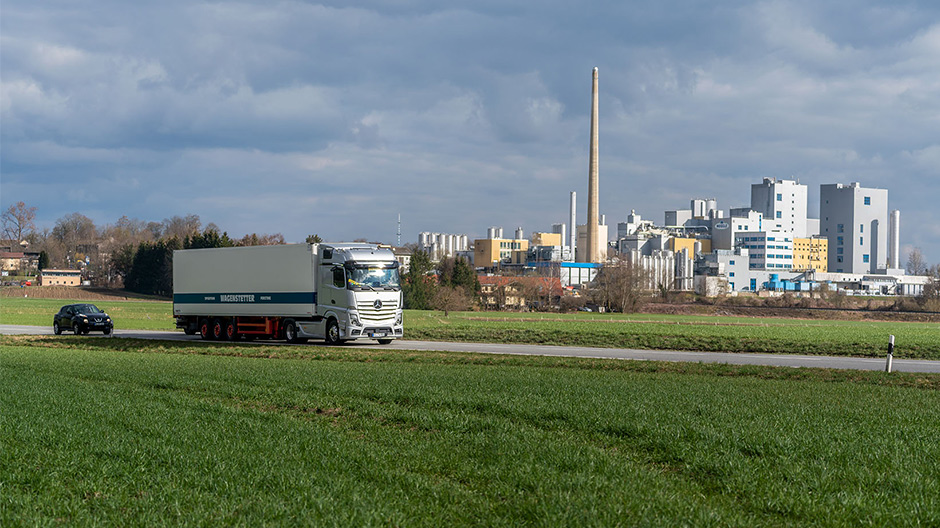
Optimised interactive systems.
It is true, of course, that Wagenstetter’s trucks do 80 to 90 percent of their driving on motorways – and the system has also been further improved to cover that segment as well: one new feature is the optimised interaction with Proximity Control Assist, with the result that Predictive Powertrain Control decelerates the truck early if a vehicle up ahead forces traffic to slow down.
There is also an innovation when it comes to driving down inclines: prior to the beginning of a descent, the system selects the gear that will ensure optimal use of the engine brake, so that use of the service brake can be minimised. This is particularly advantageous for trucks carrying heavy loads, and those in mountainous terrain. “This function performs very efficiently,” says Tom Westphal. “I am constantly on the road in the Tyrolean Alps. For example, I sometimes drive over the Brenner mountain pass four times in a single week.”
But the innovation on the new Actros that the 51-year-old likes best of all is the new MirrorCam: “It is not just the better aerodynamics; MirrorCam also produces an enormous improvement in terms of safety and handling. With those large mirrors gone, I have a much better view in every direction. I also find the distance lines very helpful, in that they help me estimate the distance to traffic following on behind me. The way that the display on the inside of a bend automatically pans when cornering is also very convenient, as it means that the end of the trailer is in my field of vision at all times.”
MirrorCam also performs better than conventional external mirrors at night and when visibility is poor, according to Tom Westphal, or “Shaggy” as everyone calls him. His verdict is clear: “I’ve already told my boss: In future I would like to drive with MirrorCam only. Don’t even bother to try and give me some other truck!”
Wagenstetter just smiles: “Life is no picnic where you can help yourself. We’ll see what happens further down the track!” Yet the entrepreneur is well aware that with today’s shortage of drivers, to find and retain good staff means he has to give them well-equipped trucks to work with. “The new Actros offers a great deal, starting with the new Multimedia Cockpit which drivers can operate like a smartphone.” And then there are all the new safety and assist systems that make it easier to get the work done and reduce stress.
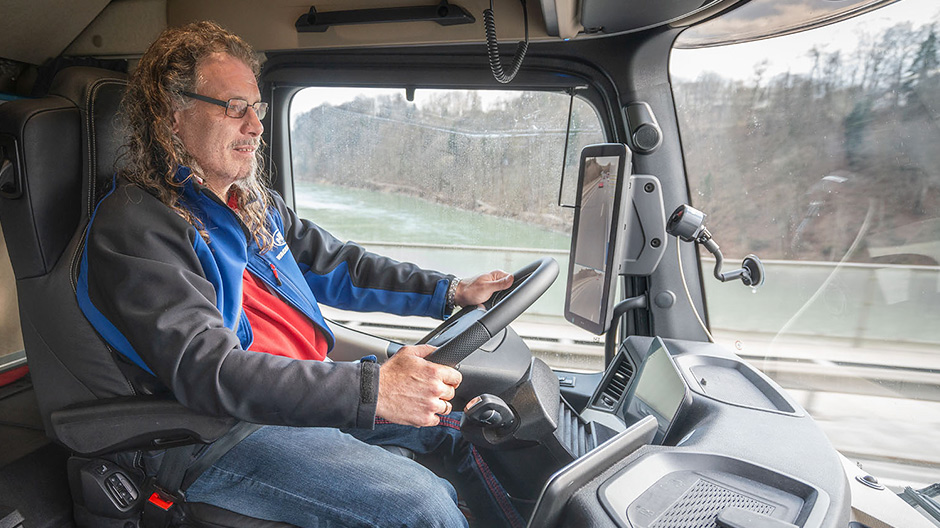
More relaxed on the road: Driver Tom Westphal is enthusiastic about such features as MirrorCam, Multimedia Cockpit and Active Drive Assist.
“Customer trials provide valuable information.”
– Rolf Knehr, development engineer, Mercedes‑Benz Trucks
Active suppport for the driver.
The trial of the new Actros at Wagenstetter also focused on the new Active Drive Assist. This system represents a major milestone in truck design, because partially automated driving across all speed ranges is now available for the first time in serial production trucks.
Active Drive Assist actively supports the driver in terms of longitudinal and lateral control of the vehicle: the system can decelerate and accelerate the truck independently, as well as keeping it on track by executing steering movements. However, the driver still has full responsibility for what happens with the vehicle and must constantly adapt his driving style to the prevailing traffic conditions.
“The system provides valuable support in a wide range of different situations: if there is a lot of traffic, Active Drive Assist helps maintain the appropriate distance to the vehicle ahead, but without wasting any space,” says Westphal.
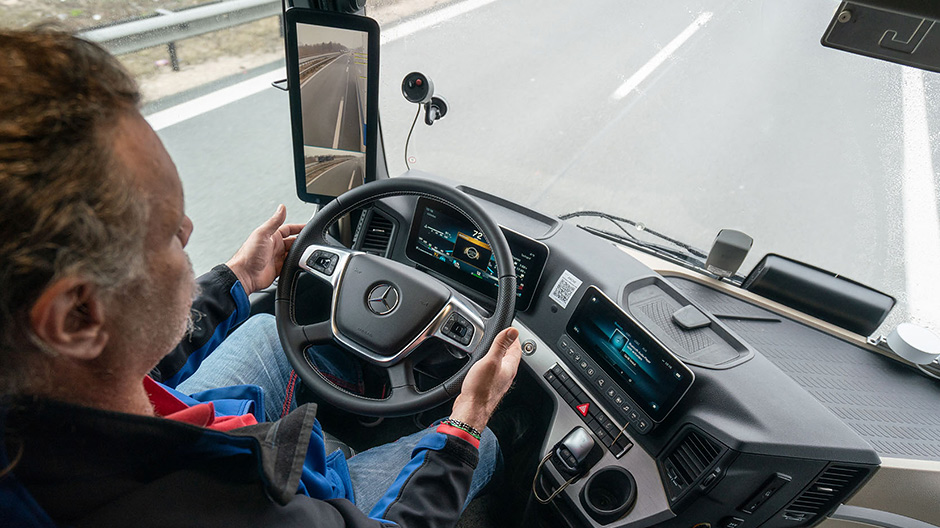
The driver is still in charge: Even though the Active Drive Assist system can actively intervene in the process of driving the vehicle – like correct the steering to stay inside the lane – the driver alone is responsible at all times. If needed, Active Drive Assist will therefore display the message: hands on the wheel!
“On long, monotonous trips, it is a bit like having a co-pilot who helps pay attention, and sometimes makes timely decisions to execute corrections as needed. When traffic is congested, Active Drive Assist is also a convenient helper thanks to its stop-and-go function. The bottom line is, the system helps me get the job done. While I still have to keep in control of everything, after nine hours behind the wheel with Active Drive Assist, I am not half as tired as I used to be without it.”
While the driver can choose to switch Active Drive Assist off, it comes on by default as soon as cruise control is activated and a preset speed is set. Once the system’s cameras have detected the lane markings on either side of the road, Active Drive Assist kicks in and supports the driver in maintaining longitudinal and lateral control of the truck. This is indicated by a blue symbol of a steering wheel and blue lane markings on the Multimedia Cockpit’s central display.
The truck’s positioning can be controlled via the multi-function steering wheel of the new Actros. On the left-hand panel* of the steering wheel, six switches are arranged in a circle: they are used to control a number of parameters, including cruise control. In the centre between these switches is the Touch Control Pad used in operating Active Drive Assist: depending on what direction the driver wants to change the truck’s position within the lane, he can swipe horizontally towards the left or right before confirming the command. He can also use the touch pad to set the gap to be maintained to the vehicle ahead. To do so, he can swipe vertically, up or down.
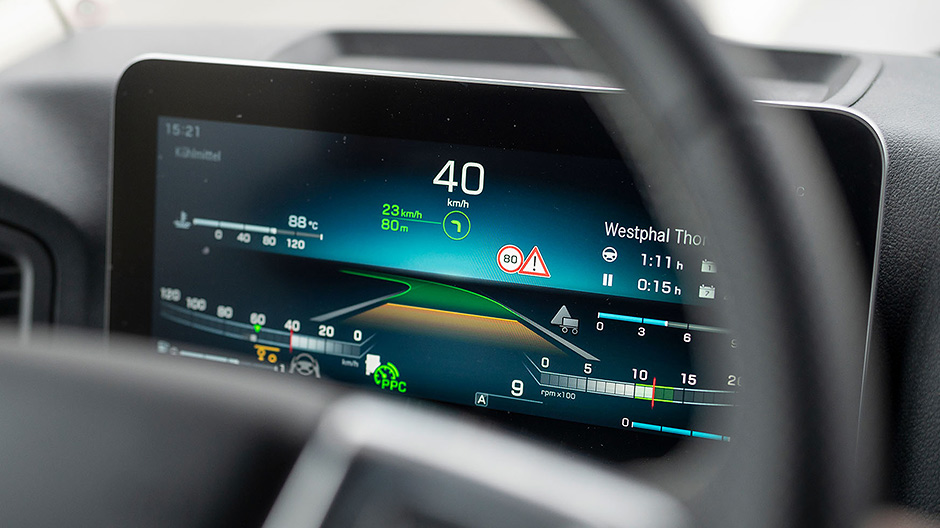
Reducing consumption automatically: Predictive Powertrain Control now also supports drivers in their efforts to save fuel on country roads – this is of particular benefit on roads with which a driver is not familiar.
A whole new driving experience.
With Active Drive Assist programmed in this way, as soon the truck comes up too close to the vehicle ahead, an icon of a vehicle up ahead appears on the central display. Active Drive Assist then slows down the truck independently. Once the appropriate gap has been restored, the system automatically accelerates the truck again until it reaches the preset speed set in the cruise control. The system performs a similarly active role in maintaining the truck’s position within its lane: if the truck is threatening to veer out of the lane, Active Drive Assist will steer it back into the centre of the lane. Another plus in terms of safety: even if the driver deactivates Active Drive Assist, the Lane Keeping Assist function still remains active. Active Drive Assist makes use of the new electrohydraulic Servotwin steering system, which boosts steering torque as needed.
“It took me a little while to get used to the system at first,” concedes Tom Westphal. “It does make a big difference in terms of the driving experience when Active Drive Assist intervenes. But it’s easy to build confidence in the system, because the corrections it makes are always appropriate and designed to enhance safety. On long hauls in particular, it has a positive effect. It is simply less stressful.”
Nikolaus Wagenstetter is also convinced of the benefits of partially automated driving: “Active Drive Assist is a system that provides our drivers with effective support, especially on motorways and express roads. A system for partially automated driving with such a wide range of functions is currently only available in the new Actros. With this system, Mercedes‑Benz Trucks has once again shown that in terms of technology, they are ahead of the competition.”
All the assist systems in the new Actros are closely attuned and work together: for example, in detecting traffic ahead as well as lane markings, Active Drive Assist uses the radar and camera equipment of the latest generation of Active Brake Assist 5, which is now standard equipment1 in all Actros trucks. Active Drive Assist also operates in accordance with the parameters set by Predictive Powertrain Control in order to drive the truck with the greatest possible fuel economy. Nikolaus Wagenstetter: “With its assist systems, Mercedes‑Benz Trucks offers a harmoniously operating overall package that substantially improves safety as well as the profitability of our business.”
[1] Standard for vehicles that are required by law to have an emergency braking assistance system.
Photos: Matthias Aletsee




Comment
Please log in to post a comment.
7 comments
Grüße Jörg 👍👍👍👍👌⛟😎
Grüße Jörg 👍👍👍👍👌⛟😎
Ansonsten: Bananen-LKW = Fahrzeug reift beim Kunden 😝😋
Ansonsten: Bananen-LKW = Fahrzeug reift beim Kunden 😝😋